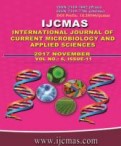


 National Academy of Agricultural Sciences (NAAS)
National Academy of Agricultural Sciences (NAAS)

|
PRINT ISSN : 2319-7692
Online ISSN : 2319-7706 Issues : 12 per year Publisher : Excellent Publishers Email : editorijcmas@gmail.com / submit@ijcmas.com Editor-in-chief: Dr.M.Prakash Index Copernicus ICV 2018: 95.39 NAAS RATING 2020: 5.38 |
A field experiment was carried out in farmer’s field where soil was deficient in available phosphorus and potassium at Kodihalli village, Magaditaluk, Ramanagara district of Karnataka during kharif-2015 to study the influence of different levels of phosphorus and potassium on growth, yield and economics of finger millet. The experiment was laid out in randomized block design comprising 16 treatments replicated thrice. The results revealed a significantly higher plant height, number of tillers hill-1 and higher 1000 grain weight in T16 (100: 75:75 kg NPK ha-1) at 90 DAS and at harvest stage respectively. Whereas significantly higher number of leaves hill-1, number of productive tillers hill-1, ear head weight, higher grain (52.03 q ha-1) and straw (87.57 q ha-1) yield was obtained in T15 (100:75:62.5 kg NPK ha-1) compared to T6 (100:50:50 kg NPK ha-1) which received nutrients as per package of practice which recorded 39.76 q ha-1 of grain and 58.78 q ha-1 of straw yield. Significantly higher 1000 grain weight was recorded in T16. Significantly the higher B: C ratio of 2.88 was recorded in treatment T15, Concluding that application 100:75:62.5 kg NPK ha-1 is helpful for getting higher yield of finger millet as well as higher economic benefit compared to the present RDF (100:50:50 kg NPK ha-1) in low phosphorus and potassium soils of Ramanagara district of Karnataka.
 |
 |
 |
 |
 |